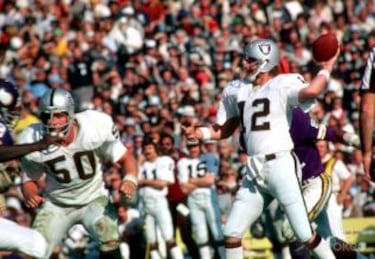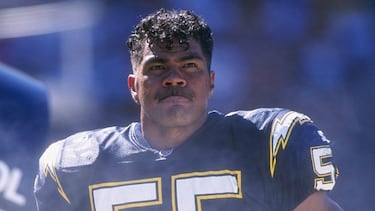In the wake of a recent study as well as a number of concussion protocols, once again the focus is on CTE and its sinister role in the NFL.

What are the most famous CTE cases in NFL history?

When tragedy strikes it’s important to get a hold of the how and why of it all. Join us as we take a look at the sad stories of some of the most famous players in NFL history who have suffered from the degenerative brain disease known as CTE.
What is C.T.E.?
Chronic traumatic encephalopathy otherwise known as CTE has affected boxers since the 1920s, according to the C.T.E. Center at Boston University, however, it came to the attention of a much wider audience in 2007 after a New York Times article revealed that former player Andre Waters had sustained brain damage from playing football, which led to his depression and ultimate death by suicide.
The degenerative brain disease is directly related to repeated blows to the head and has been found in the brains of more than 315 former N.F.L. players including some 24 who died in their 20s and 30s. What’s more, is that according to a study published by researchers at Boston University in February 2023, CTE was found in 92% of former NFL players who were analyzed.
Indeed, the university explained that of the 376 brains of deceased former NFL players that were studied, 345 of them were diagnosed with CTE
What makes the disease all the more cruel, is that it can only be identified during a post-mortem autopsy, however, symptoms of the condition can be observed for years before death as we will learn below. Where the symptoms themselves are concerned, we can look to a description made by Michael Alosco, PhD, and postdoctoral fellow with the Alzheimer’s Disease and CTE Center at Boston University. “Often times in CTE, memory problems, difficulty multitasking, behavior problems such as aggression, and mood problems including depression worsen over time. If they live into older age, those with CTE will develop dementia.
How was C.T.E. first observed?
In 2002 former American football player Mike Webster died as a result of a heart attack at the age of 50. The legendary Steeler’s center, nicknamed “Iron Mike,” had won the Super Bowl on four occasions and was as successful as they come, yet his life after retiring did not reflect that in the least. Webster’s life would enter into a downward spiral as he lost his memory, got divorced, stopped eating, and was even sleeping in his car.
It was a sad end to what could have otherwise been a happy and fulfilling life. The description of what happened in his life is one that would tragically become common among former players such that it soon became an issue that begged an explanation and that’s exactly what Webster’s autopsy would offer.
Pittsburgh Steeler Legend, Iron Mike Webster (B-Day), 4X Super Bowl Champ, 9X Pro Bowl, Pro Football HOF. Tragically, Mike was living out of his truck & in various train stations post-NFL due to brain trauma (CTE) from 17 seasons playing center.
— Sean Mcdowell (@dvesean) March 18, 2022
Mike was only 50 when he d. 2002. pic.twitter.com/kTIELeIsAj
Spread across the former center’s brain were little brown and red dots. Known as tau proteins, they are the key drivers in dementia as they slowly spread across the brain killing cells as they do. The results of Webster’s autopsy would later be published in a journal of neurosurgery where they would be referred to for the first time as ‘Chronic Traumatic Encephalopathy’ (C.T.E.)
What famous NFL players have suffered from C.T.E?
To date, researchers have diagnosed CTE in 110 out of the 111 former NFL players who have donated their brains for study. That group includes five of the league’s most legendary players which we will break down for you:
Aaron Hernandez
On April 19th, 2017, at approximately 3 a.m. the former New England Patriots tight end was found hanging from a bed sheet in his prison cell in Shirley, Massachusetts. Aaron Hernandez had recently been found not guilty of a 2012 double homicide, so one can imagine that his suicide came as a complete shock. A postmortem brain scan would later reveal that Hernandez had been suffering from CTE. The scan which was performed by Ann McKee, PhD, lead researcher of the CTE Center at Boston University, showed evidence of brain atrophy, damage to the frontal lobe, and large portions of black spots created by tau proteins. “We’ve never seen this in our 468 brains, except in individuals some 20 years older,” Dr. McKee said in 2017.

It should be said that Hernandez also displayed all of the typical signs of CTE during his lifetime, including: changes in mood, depression, aggression, irritability, impulsivity, and anxiety. He also suffered from constant headaches, migraines and memory problems.
Incidentally, Hernandez’s family filed a $20 million lawsuit against the New England Patriots and the NFL following his CTE diagnosis. The lawsuit contested that the league and franchise “were fully aware of the damage that could be inflicted from repetitive impact injuries and failed to disclose, treat, or protect him from the dangers of such damage.”
Frank Gifford
A versatile player for the New York Giants, Frank Gifford won five NFL championships in the 1950s and 1960s. Though he died of natural causes, Gifford’s family released a statement in 2015 that confirmed a postmortem diagnosis of CTE. According to an article from 2015, the family’s statement went on to say: “We... find comfort in knowing that by disclosing his condition we might contribute positively to the ongoing conversation that needs to be had; that he might be an inspiration for others suffering with this disease that needs to be addressed in the present; and that we might be a small part of the solution to an urgent problem concerning anyone involved with football, at any level.”
Frank Gifford died with CTE. Here he is unconcious on the football field. pic.twitter.com/kKHKyX5oTe
— Greg Ransom (@GregRansom) June 13, 2020
Some will remember that it was in fact Gifford who took one of the most notorious hits in NFL history when he was subjected to a brutal tackle by Eagles linebacker Chuck Bednarik in November of 1960. Gifford was in the hospital for 10 days and subsequently would go two years before playing again. He suffered from confusion and short-term memory loss. “It’s hard to do,” Gifford once said during his efforts to see the NFL implement better helmet protection for players. “You have to start in high school and get them to play the right way. And it’s hard on officials, whether on the field or in the league office, who have to be judge and jury.”
Ken Stabler
With 27,938 passing yards during his 15-year NFL career playing for the Oakland Raiders, the Minnesota Vikings, the Houston Oilers, and the New Orleans Saints, Ken Stabler was a legend. The native of Foley, Alabama was named the NFL’s Most Valuable Player in 1974 and would go on to lead the Raiders to a Super Bowl win in 1977. Stabler’s long time partner Kim Bush would explain after his death that the former NFL great suffered from severe headaches in addition to disorientation and forgetfulness. “We talked at length about head injury,” Bush said at ther time. “He was certain that he was suffering from the consequences of playing football.”

Stabler who died of colon cancer at the age of 69 requested that his brain be donated to the Boston University CTE Center. After studying his brain it was confirmed that he did in fact suffer from CTE and that the disease was widespread throughout his brain, with severe damage to the areas involved in learning, memory, and regulation of emotion. Stabler’s case remains an intriguing one because of the fact that he more or less understood what he was suffering from even before his death.
Chris Nowinski, the founder of the Concussion Legacy Foundation said that it was interesting that Stabler anticipated his diagnosis years in advance. “And even though he’s a football icon, he began actively distancing himself from the game in his final years, expressing hope that his grandsons would choose not to play,” he said. Stabler’s plight was also unique because of the fact that he was a quarterback, a position that does not normally receive the number of tackles that others do.
“While we know on average that certain positions experience more repetitive head impacts and are more likely at greater risk for CTE, no position is immune,” McKee of Boston University said.
Andre Waters
In November of 2006, former Philadelphia Eagles defensive back Andre Waters went outside onto the pool deck of his Tampa home with a .32-caliber pistol and took his own life at the age of 44.
“Football killed him,” Bennet Omalu, MD was quoted at the time after he had performed an examination on Waters’ brain. Omalu would also add that Waters’ brain tissue resembled that of an 85-year-old in the early stages of Alzheimer’s. “If Waters had lived another 10 to 15 years, he would’ve been fully incapacitated,” Omalu said in an article published in The New York Times.
Today would have been former #Eagles & #TecmoSuperBowl SS Andre Waters 59th birthday. The member of the Eagles 75th Anniversary Team & 12-year #NFL vet was lost in 2006 to suicide. It was revealed he dealt with CTE. The #NFL needs to step up and do more to help these players. pic.twitter.com/UAi9lJ202N
— SBlueman (@SBluemanTecmo) March 10, 2021
Waters racked up hundreds of tackles in his 12 seasons with the Eagles and the Arizona Cardinals. On the field, Waters was nicknamed “Dirty Waters” for his aggressive style of tackling, which, to no surprise, often involved the use of his head. “He used his head a lot,” Waters’ former high school coach, Antoine Russell, told the Palm Beach Post.
“When we were in school, because I knew our insurance was not too good, I tried so many times to stop him.” Known as a brother to his teammates, a generous friend and loving son to his mother, the former great sadly developed severe depression in his later life and eventually succumbed to it.
Junior Seau
It was back in May 2012 when Oceanside, California, police responded to a phone call from Seau’s girlfriend, who found him unconscious with a gunshot wound to the chest. Seau’s untimely death came just a short time after the 2011 suicide of former Chicago Bears player Dave Duerson, who also suffered from CTE incidentally also shot himself in the chest.

One of the NFL’s most brutal linebackers, Seau played across 20 seasons in the league with the San Diego Chargers, the Miami Dolphins, and the New England Patriots. When it comes to accolades, his list is extensive. A 10-time All-Pro select, 12-time Pro Bowl, a member of the 1990 All-Decade Team, and a 2015 Pro Football Hall of Fame inductee, Seau was a legend. After his suicide, Seau’s family demanded that his brain be examined for signs of CTE.
According to the autopsy report published in February 2016 in the journal World Neurosurgery, Seau’s brain revealed abnormalities consistent with CTE and similar to autopsies of people with “exposure to repetitive head injuries.” Interestingly, the NFL responded to the findings of the journal saying that the report “underscores the recognized need for additional research to accelerate a fuller understanding of CTE.” The league then gave a $30 million research grant to the NIH so that they could explore CTE and promote the long-term safety of athletes at all levels.
A recent case: Dolphins’ Tua Tagovailoa isn’t concerned about CTE
You may recall that in September 2022, Miami Dolphins quarterback Tua Tagovailoa was placed in concussion protocol after a brutal hit during a game against the Cincinnati Bengals left him with a concussion. Then, just three months later Tagovailoa was once again placed in concussion protocols after his head hit the ground during a game against the Green Bay Packers.
What followed were calls for the Dolphins’ signal caller to retire, and to be fair he himself revealed that he considered bringing the curtain down on his career. Yet, that turned out to not be the case and so here we are now with the 25-year-old having spearheaded his team’s dramatic 36-34 win over the Los Angeles Chargers on Sunday night - Week 1 of the 2023-24 NFL season - and many declaring him to be the front runner for this season’s MVP award. The question is of course, ‘Should Tua Tagovailoa be playing?’
Neuropathologist, Bennet Omalu, feels now is the time for Tua Tagovailoa to walk away from the game of football.
— The Sporting News (@sportingnews) October 4, 2022
Omalu was the first to discover CTE and the disturbing behavioral symptoms associated with the disease. pic.twitter.com/7caKUHOZ7b
Well, to hear him tell it, the answer is ‘yes.’ Having received the green light from doctors - they remain unnamed - Tagovailoa has maintained the position that last season’s concussions in no way increase the likelihood of suffering anymore in 2023, such that the specter of CTE “wasn’t going to be a problem” for him. “It’s only when you’re constantly hitting your head against something,” Tagovailoa said back in April. “So I think that tailors more towards linebackers, O-linemen, D-linemen − guys that are constantly going at it.”
Related stories
Now, it’s important to understand here that Tagovailoa’s comments were immediately met with skepticism from neurologists and academics who study CTE. Indeed, they believe that the young quarterback doesn’t fully understand the health risks that he’s voluntarily assuming by returning to the field.
“If somebody told him he doesn’t have to worry about CTE, then he is definitely being misled, based on what we know today,” said Chris Nowinski, the co-founder and chief executive officer of the nonprofit Concussion Legacy Foundation. Further to that, Nowinski along with other professionals in the field were questioned on a range of topics such as the potential risks facing Tagovailoa, the possibility of an increased likelihood that he contracts CTE, and whether the position he plays changes the risk involved. While the answers to those questions remain complicated, what is simple is the idea that Tagovailoa himself believes that he’s good to go. “I think I’m far, far ahead,” he said Thursday. “It hasn’t been a thought ever since it’s happened. Ever since I’ve been cleared, it’s never been a thought to look back at that.”


Complete your personal details to comment